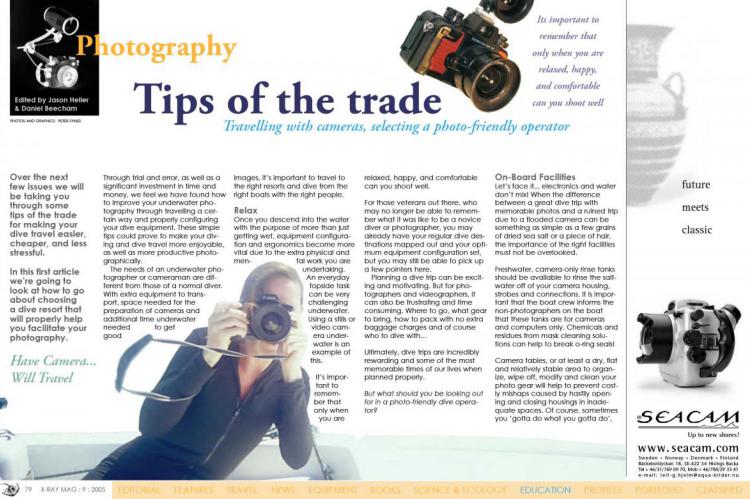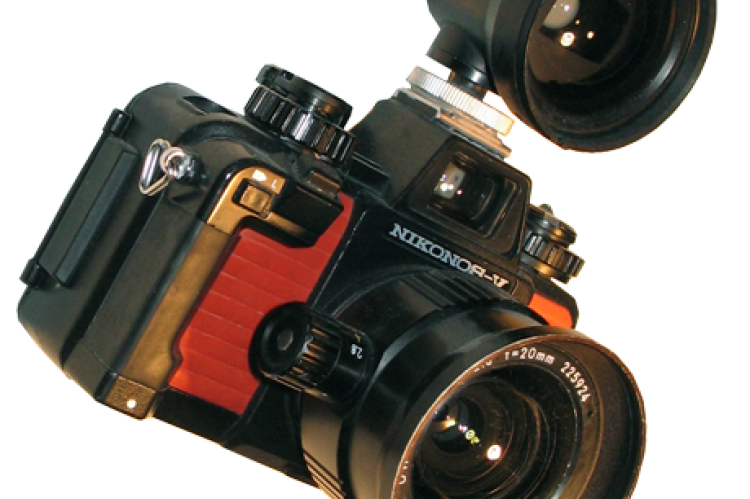Travel tips for Photographers
Have Camera...Will Travel.
Travelling with cameras, selecting a photo-friendly operator.
Tags & Taxonomy
Through trial and error, as well as a significant investment in time and money, we feel we have found how to improve your underwater photography through travelling a certain way and properly configuring your dive equipment. These simple tips could prove to make your diving and dive travel more enjoyable, as well as more productive photographically.
The needs of an underwater photographer or cameraman are different from those of a normal diver. With extra equipment to transport, space needed for the preparation of cameras and additional time underwater needed to get good images, it’s important to travel to the right resorts and dive from the right boats with the right people.
Relax
Once you descend into the water with the purpose of more than just getting wet, equipment configuration and ergonomics become more vital due to the extra physical and mental work you are undertaking. An everyday topside task can be very challenging underwater. Using a stills or video camera underwater is an example of this.
It’s important to remember that only when you are relaxed, happy, and comfortable can you shoot well.
For those veterans out there, who may no longer be able to remember what it was like to be a novice diver or photographer, you may already have your regular dive destinations mapped out and your optimum equipment configuration set, but you may still be able to pick up a few pointers here.
Planning a dive trip can be exciting and motivating. But for photographers and videographers, it can also be frustrating and time consuming. Where to go, what gear to bring, how to pack with no extra baggage charges and of course who to dive with…
Ultimately, dive trips are incredibly rewarding and some of the most memorable times of our lives when planned properly.
But what should you be looking out for in a photo-friendly dive operator?
On-Board Facilities
Let’s face it... electronics and water don’t mix! When the difference between a great dive trip with memorable photos and a ruined trip due to a flooded camera can be something as simple as a few grains of dried sea salt or a piece of hair, the importance of the right facilities must not be overlooked.
Freshwater, camera-only rinse tanks should be available to rinse the saltwater off of your camera housing, strobes and connections. It is important that the boat crew informs the non-photographers on the boat that these tanks are for cameras and computers only. Chemicals and residues from mask cleaning solutions can help to break o-ring seals!
Camera tables, or at least a dry, flat and relatively stable area to organize, wipe off, modify and clean your photo gear will help to prevent costly mishaps caused by hastily opening and closing housings in inadequate spaces. Of course, sometimes you ‘gotta do what you gotta do’, to dive when and where you want, and sometimes the facilities just aren’t available. Keep in mind that leaving your camera in saltwater, or even wrapped in a wet towel, is better than allowing it to dry prior to a freshwater rinse.
On-Resort Facilities
Many land-based and live-aboard operators offer dedicated camera charging areas, digital workstations, accessories for sale, rentals and photo processing. Having a library of marine life ID books also helps to identify the creatures and corals that you have shot and may want to shoot during a trip. Photographers who understand the habitats in which they are diving and the behaviour of the inhabitants, will usually come home with better and more varied images.
Dive Guides
An experienced dive guide with local experience is invaluable. They know the reefs and the tides, and understand the behavioural patterns of the local marine life sometimes with impeccable accuracy. Four eyes are always better than two, especially when two of the eyes watch these reefs day in and day out. Having dive guides who are also photographers or videographers can be an additional plus. Beyond pointing out great photo opportunities, on-staff photo pros sometimes offer workshops and lessons.
Environmental Responsibility
As divers, we are all ambassadors of the sea. We should support dive operators who demonstrate environmental responsibility and support local conservation efforts, and patronize resorts and live-aboards who use biodegradable soap and detergents. Dive operators can also help support the local economies by employing locals and even training them as dive guides, which in some regions results in less fishing pressure on the reefs.
Long term, as a community of travelling divers, we must support the local communities, directly or indirectly, who we need in order to support the reefs that we love (and as a world, need) so much. By diving with operators who are environmentally responsible and better yet, involved in conservation efforts, you are supporting these communities and the reefs.
Safety
The number one consideration on any dive trip should always be safety. In order to come home with great pictures, you need to come home in one piece!
Some of the basics include oxygen and first aid on board, a working radio and an able crew with local experience. If you’re diving in a more remote destination, you will want to inquire about the closest recompression chamber and emergency procedures. You may even want to inquire about back-up engines and boat maintenance.
Birds of a Feather…
Some photographers choose to dive only on special photography-oriented group trips often guided by a professional photographer. Many of these trips include ...
(...)
Download the full article ⬇︎

Originally published
X-Ray Mag #09
FOCUS: PHILIPPINES: Dumaguate - Ligpo Island - Malapascua - Dauin - Profile: Phil Nyutten :: Guadalupe Sharks :: Worlds Deepest Wreck Dive :: Portfolio: Ray Troll : Valentines Gifts :: The First Frogmen, part 2 :: Nova Scotia :: Photography and Travelling ... and much more more



